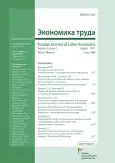Managing the development of the occupational safety and health system in the modern economy on the basis of homeostatic modeling
- Authors: Samarskaya N.A.1
-
Affiliations:
- All-Russian Research Institute of Labour of the Ministry of Labour and Social Protection of the Russian Federation – Ural Interregional branch
- Issue: Vol 10, No 8 (2023)
- Pages: 1287-1300
- Section: Articles
- URL: https://journals.rcsi.science/2410-1613/article/view/146265
- DOI: https://doi.org/10.18334/et.10.8.118531
- ID: 146265
Cite item
Abstract
About the authors
Nadezhda Aleksandrovna Samarskaya
All-Russian Research Institute of Labour of the Ministry of Labour and Social Protection of the Russian Federation – Ural Interregional branch
Email: samarskaya_na@mail.ru
Кандидат экономических наук, доцент, заместитель директора
References
- Горский Ю.М. Основы гомеостатики: курс лекций. - Иркутск: Изд-во Иркут. экон. акад., 1995. – 125 c.
- Горский Ю.М. Основы гомеостатики: гармония и дисгармония живых, природных, социальных и искусственных систем. - Иркутск, 1998.
- Горский Ю.М. Гомеостатика: модели, свойства, патологии. / Гомеостатика живых, технических, социальных и экологических систем. - Новосибирск: Наука, 1990. – 20-67 c.
- Гомеостатика природных, социальных и технических систем. / Сб.н.тр. - Иркутск: Изд-во СЭИ, 2000. – 280 c.
- Боуш Г.Д., Разумов В.И. Методология научного исследования (в кандидатских и докторских диссертациях). / учебник. - Москва : ИНФРА-М, 2021. – 227 c.
- Боуш Г. Д. Гомеостатическое моделирование управления функционированием и развитием региональных экспортоориентированных кластеров // Вестник Омского университета. Серия: Экономика. – 2011. – № 3. – c. 66-73.
- Боуш Г. Д. Механизм функционирования кластеров предприятий: теория и методология исследования // Региональная экономика: теория и практика. – 2011. – № 3. – c. 59-66.
- Самарская Н.А. Охрана труда в категориях простой модели компенсационного гомеостата // Экономика труда. – 2023. – № 6. – c. 823-842.
- Самарская Н.А., Елин А.М. Охрана труда в системной методологии // Экономика труда. – 2023. – № 4. – c. 615-634.
- Самарская Н.А. Особенности и принципы формирования системы охраны труда на базе межкомпонентных отношений // Социально-трудовые исследования. – 2023. – № 2 (51). – c. 130-140.
Supplementary files








